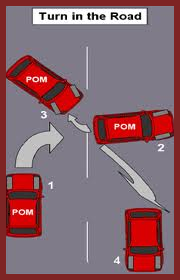Turn In The Road

The turn in The Road exercise is sometimes commonly known as a “three point turn.” This phrase is misleading, as it suggests the exercise must be completed in three manoeuvres. On the driving test however, it is not that uncommon for candidates to need five manoeuvres to complete their turn, as they may be on a narrow road, or have a vehicle which is too long to complete the turn in three moves. So, although candidates should aim to take as few “moves” as possible, taking five is by no means an “Automatic Fail.” What is important, is that the exercise is completed under full control, with due regard for other road users.
Before “Turning in the road” you should:
Assess if you are likely to be a serious inconvenience to the traffic flow. If so, use an alternative like driving round the block, reversing into a side road, or turn around at a roundabout.
Assess if the road has a “camber,” and also the width of the road. If the road is really narrow, use one of the above alternatives.
During Turning In The Road you should:
Maintain control of the vehicle at all times.
Avoid hitting the kerb (not necessarily a fail on the driving test if the car “touches” the kerb.)
Avoid turning the steering wheel while the car is stationary. This is known as “Dead” or “Dry” steering, which strains steering components and scrubs tyres.
Observe constantly for approaching road users and be prepared to give way.
EXERCISE STAGES:
Stage 1:
Your aim should be to direct the front of the car to being as near to “right angled” with the opposite kerb as possible.
Prepare
Prepare the vehicle as you would do to move off normally, with regard to moving uphill, downhill, or on the level – clutch just below bite on flat ground, gas set and clutch at bite if facing uphill, footbrake held down and clutch down if facing downhill.
Observe
Look all round you REALLY CAREFULLY, and give way to approaching traffic, including cyclists and pedestrians. Remember, your vehicle would be the one causing the obstruction.
Manoeuvre
Once you are sure it is safe, release the handbrake and begin to move the car at a crawling speed. As soon as the car is moving you can steer briskly and fully to the right. Nearing the centre of the road, it would be a good idea to look up and down the road again to update for approaching traffic. If you are on a road with a camber the vehicle will reach a “Tipping Over” point, where it is no longer travelling uphill, and begins to move downhill. This will usually mean transferring your feet from using “clutch control,” to using the footbrake and depressing the clutch to use “brake control.” As the car begins to near the opposite side of the road, turn the steering wheel back to the left to straighten the front wheels. Stop before the front of the vehicle overhangs the kerb, and apply the handbrake.
Stage 2:
This is the reversing part of the manoeuvre and using reverse gear allows more manoeuvrability than in a forward gear.
Prepare
Select reverse. Again, take account of whether you will be moving up, down or level and prepare accordingly.
Observe
Look carefully all around you and only move if it is safe. If traffic is approaching wait and give them the opportunity to pass
Manoeuvre
Looking over your left shoulder, release the handbrake smoothly and fully. Now begin to move the car at a crawling speed, while steering fully to the left. When the car is about halfway across the road, look up and down the road again, remember if your road is cambered you will be close to the “tipping point” now, so be ready to push the clutch down and use the footbrake. As you cross the centre of the road, turn round and look over your right shoulder towards the rear of the car and the kerb behind it. As the rear nears the kerb, begin to steer back to the right to straighten the steering wheels. Stop as gently as possible, making sure that the car does not overhang the kerb. Now apply the handbrake. So far so good!
Stage 3:
The final stage if the road is wide enough but remember it may be necessary to take more manoeuvres.
Prepare
Once again, take note of any gradient and make sure you have prepared to move off accordingly.
Observe
All round observation. Again, give approaching traffic the opportunity to pass but avoid waving them on. Remember to look to the rear for pedestrians etc. behind the car – if they are passing, wait.
Manoeuvre
Manoeuvre slowly, as previously described. Steer until your vehicle becomes parallel to the opposite kerb, but if you won’t make it stop again and reverse. Job Done!
